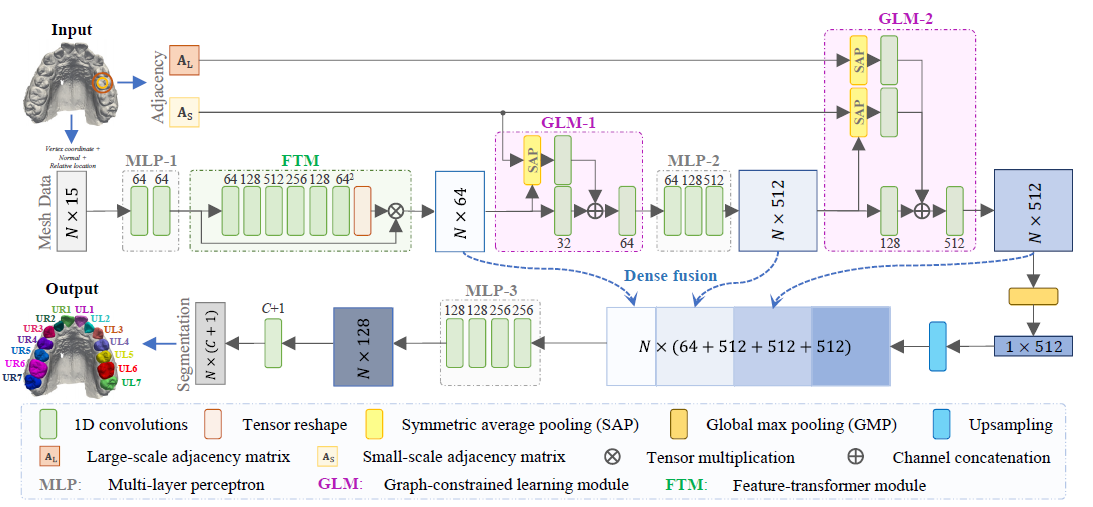MeshSegNet: Deep Multi-Scale Mesh Feature Learning for Automated Labeling of Raw Dental Surface from 3D Intraoral Scanners
Created by Chunfeng Lian, Li Wang, Tai-Hsien Wu, Fan Wang, Pew-Thian Yap, Ching-Chang Ko, and Dinggang Shen
python 3.7.6
pytorch 1.6.0
numpy 1.18.1
pandas 1.1.3
vedo 2020.4.2
scikit-learn 0.22.1
visdom 0.1.8.9 (optional; for step3)
thundersvm (optional; for step6)
pygco (0.0.1) (optional; for step6)
This work is the pytorch implementation of MeshSegNet, which has been published in IEEE Transactions on Medical Imaging (https://ieeexplore.ieee.org/abstract/document/8984309) and MICCAI 2019 (https://link.springer.com/chapter/10.1007/978-3-030-32226-7_93). MeshSegNet is used to precisely label teeth on digitalized 3D dental surface models acquired by Intraoral scanners (IOSs).
In this repository, there are three main python scripts (steps 1 to 3) and three optional python scripts (steps 3-1, 4, and 5). Unfortunately, we are unable to provide the data. Please see below for the detailed explanation of codes.
In order to increase the training dataset, we first augment the available intraoral scans (i.e., meshes) by 1) random rotation, 2) random translation, and 3) random rescaling of each mesh in reasonable ranges.
In this work, our intraoral scans are stored as VTP (VTK polygonal data) format. To read, write, and manipulate VTP files, we use vedo. Please refer to https://github.com/marcomusy/vedo. In our work, we have 36 intraoral scans, and all of these scans have been downsampled previously. We use 24 scans as the training set, 6 scans as the validation set, and keep 6 scans as the test set. For training and validation sets, each scan (e.g., Sample_01_d.vtp) and its flipped (e.g., Sample_01001_d.vtp) are augmented 20 times. All generated augmented intraoral scans (i.e., training and validation sets) will be saved in “./augmentation_vtk_data” folder.
In step1_augmentation.py, the variable “vtk_path” needs to define, which is the folder path of intraoral scans. Then you can implement this step by the following command.
python step1_augmentation.pyIn stpe2_get_list.py, please define variables “num_augmentation” and “num_samples” according to step1_augmentation.py. Since we use 24 of 30 scans as training data, the “train_size” is set to 0.8. You can implement this step by the following command.
python step2_get_list.pyThen, two CSV files (i.e., train_list.csv and val_list.csv) are generated in the same folder.
In step3_training.py, please define variable “model_name” used for visdom environment and output filename. If your system doesn’t have visdom, please set variable “use_visdom” as False. In this work, the number of classes is 15, second molar to second molar (14 teeth) and gingiva. The number of features is 15, corresponding to cell vertices (9 elements), cell normal vector (3 elements), and the relative position (3 elements). To further augment our dataset, we select all tooth cells (i.e., triangles) and randomly select some gingival cells to form 6,000 cells inputs based on original scans in “./augmentation_vtk_data” during training. To prepare the input features and further augmented data as well as computing adjacent matrixes (AS and AL, refer to the original paper for detail) are carried out by Mesh_dataset.py. The network architecture of MeshSegNet is defined in meshsegnet.py.
You can start to train a MeshSegNet model by the following command.
python step3_training.pyWe provide two trained models (an upper and a lower) and the training curves in “./models” folder.
Optional:
If you would like to continue to train your previous model, you can modify step_3_1_continous_training.py accordingly and execute it by
python step3_1_continous_training.pyOnce you obtain a well-trained model, you can use step4_test.py to test the model using your test dataset. Please define the path of the test dataset (variable “mesh_path”) and filename according to your data. To implement this step, by entering
python step4_test.pyThe deployed results will be saved in “./test” and metrics (DSC, SEN, PPV) will be displayed.
step5_predict.py is very similar to step4_test.py. Once you set the data path and filename accordingly, it can predict the tooth labeling on unseen intraoral scans. The deployed results will be saved in “./test” as well. No metrics will be computed because the unseen scans do not have ground truth.
To implement this step, by entering
python step5_predict.pyNote that this step will downsample mesh if number of cells > 10,000. Otherwise most likely it will have insufficient GPU memory error.
Our publication in IEEE Transactions on Medical Imaging (https://ieeexplore.ieee.org/abstract/document/8984309) mentioned the multi-label graph-cut method to refine the predicted results. To do that, by implementing
python step6_predict_with_post_processing_pygco.pyThe multi-label graph cut is implemented by the python package pygco.
The MeshSegNet code is released under MIT License (see LICENSE file for details).
If you find our work useful in your research, please cite:
- C. Lian et al., "Deep Multi-Scale Mesh Feature Learning for Automated Labeling of Raw Dental Surfaces From 3D Intraoral Scanners," in IEEE Transactions on Medical Imaging, vol. 39, no. 7, pp. 2440-2450, July 2020, doi: 10.1109/TMI.2020.2971730.
- Lian C. et al. (2019) MeshSNet: Deep Multi-scale Mesh Feature Learning for End-to-End Tooth Labeling on 3D Dental Surfaces. In: Shen D. et al. (eds) Medical Image Computing and Computer Assisted Intervention – MICCAI 2019. MICCAI 2019. Lecture Notes in Computer Science, vol 11769. Springer, Cham. https://doi.org/10.1007/978-3-030-32226-7_93
- Wu TH. et al. (2021) Machine (Deep) Learning for Orthodontic CAD/CAM Technologies. In: Ko CC., Shen D., Wang L. (eds) Machine Learning in Dentistry. Springer, Cham. https://doi.org/10.1007/978-3-030-71881-7_10
